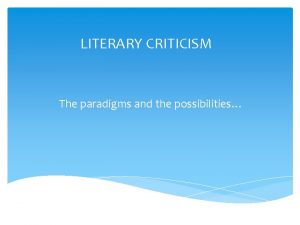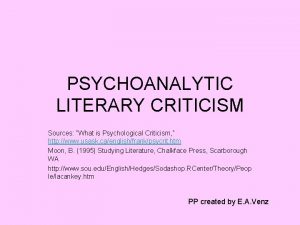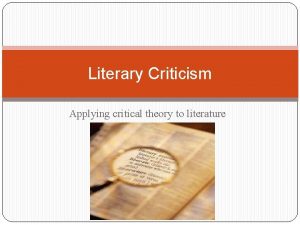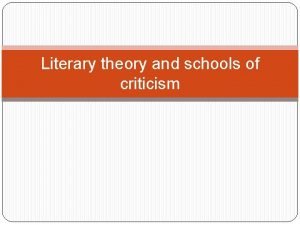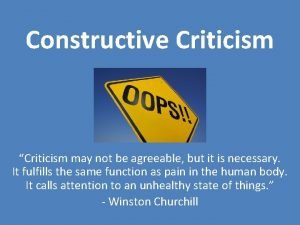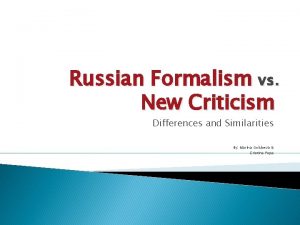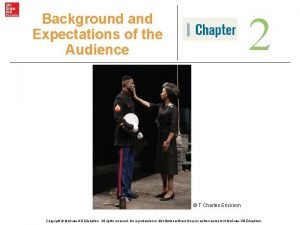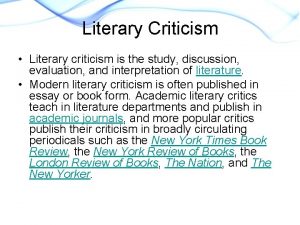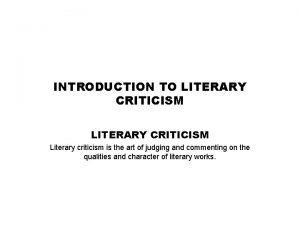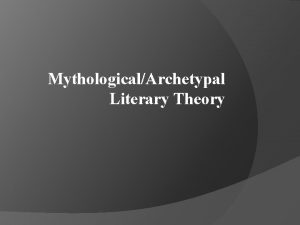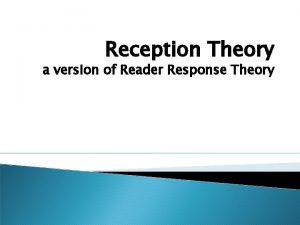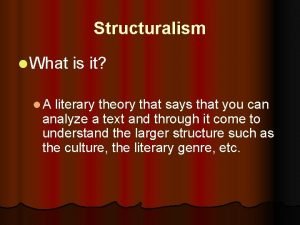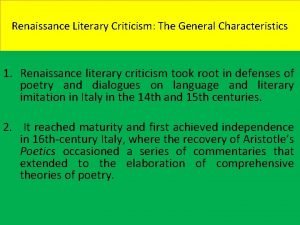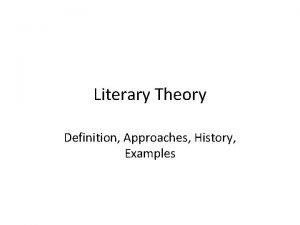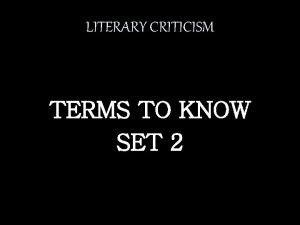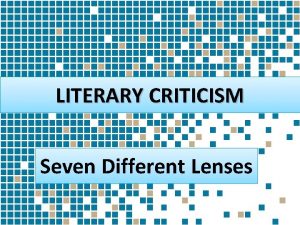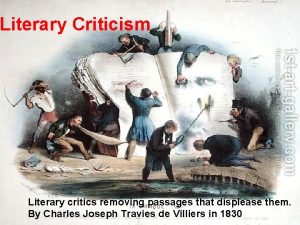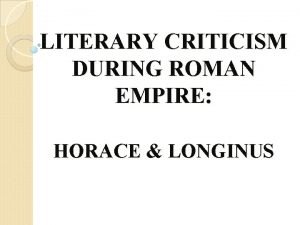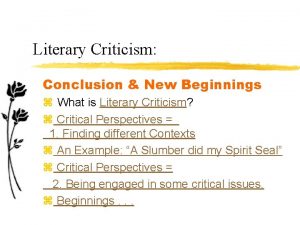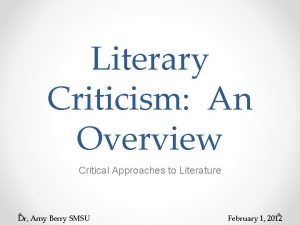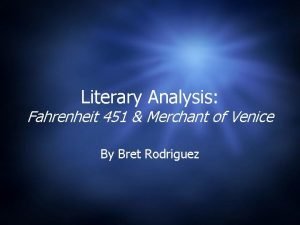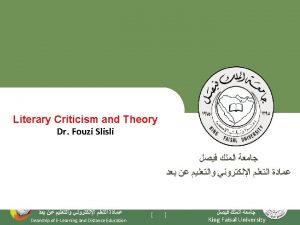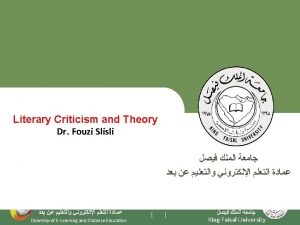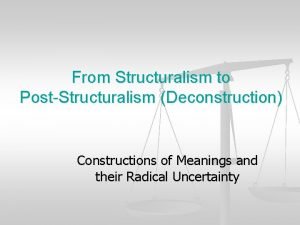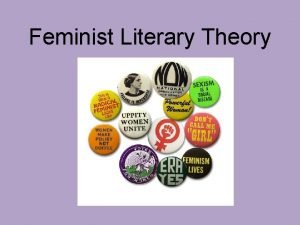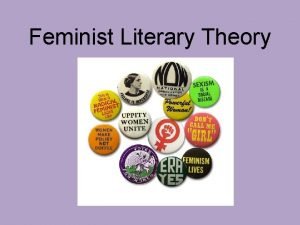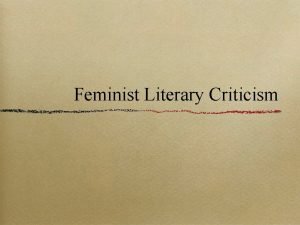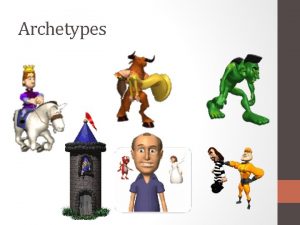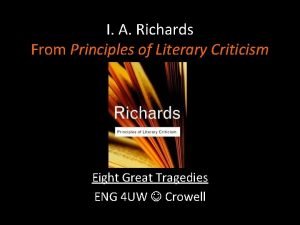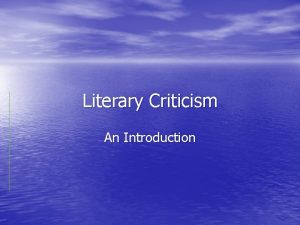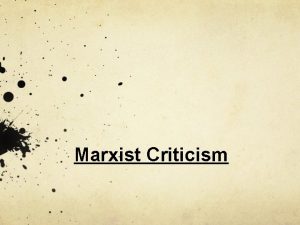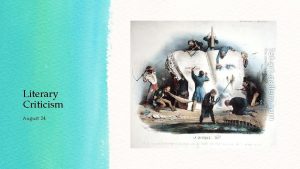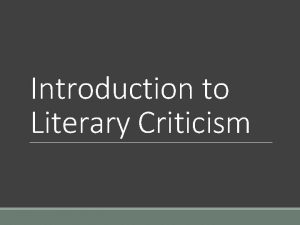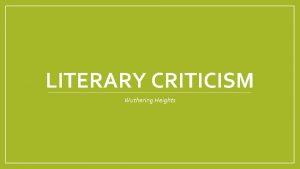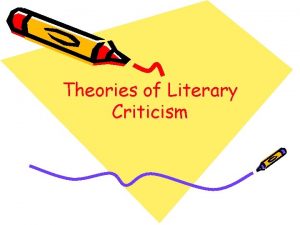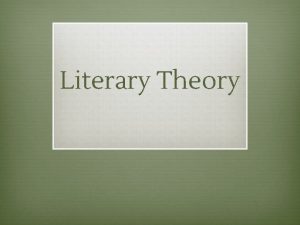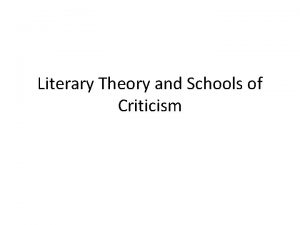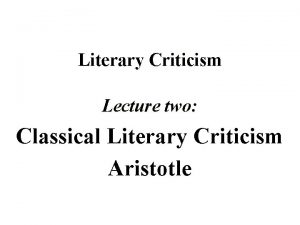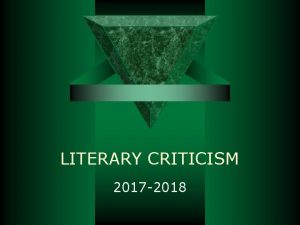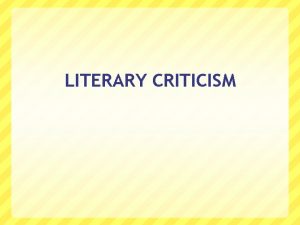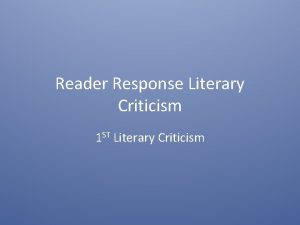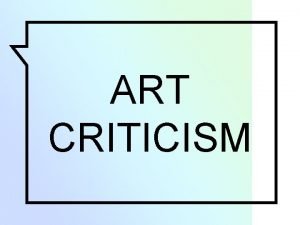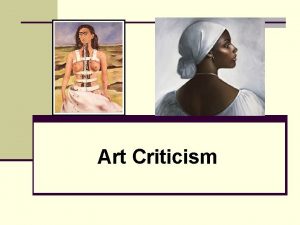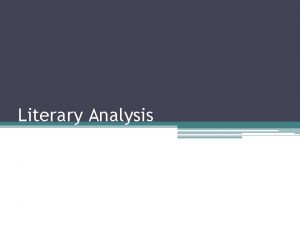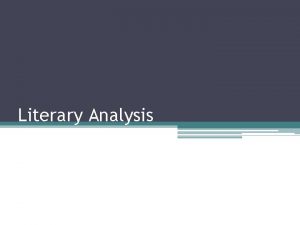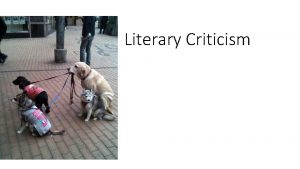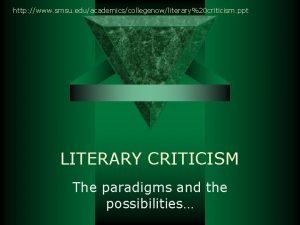Introduction to Literary Criticism Literary Criticism and Theory































- Slides: 31

Introduction to Literary Criticism

Literary Criticism and Theory l Any piece of text can be read with a number of different sets of “glasses, ” meaning you are looking for different things within the text. l Literary Criticism helps readers understand a text in relation to the author, culture, and other texts.

The Most Common Critical Stances for Literature l Formalistic l Biographical l Historical/Cultural l Psychological l Mythological l Gender l Deconstructionist

Formalist Criticism (p. 2095) A formalist (aka New Criticism) reading of a text focuses on symbol, metaphor, imagery, and so on. l Formalism ignores the author’s biography and focuses only on the interaction of literary elements within the text. l It’s what you do most often in English literature. l

A Formalist Reading of “The Three Little Pigs” l What does the wolf symbolize? l Notice the consonance of “I’ll huff and I’ll puff…” l How does the story foreshadow the final fate of the pigs? l What does the wolf’s dialogue tell us about his character?

Biographical Criticism (p. 2097) As the name suggests, this type of criticism reads the text looking for the author’s influence. l By examining the author’s life, we can have a deeper understanding of his writing. l

A Biographical Reading of The Importance of Being Earnest l Wilde had an intimate knowledge of “Bunburying” because he led a doublelife too in his homosexual relationship with a young Oxford student. l The characters’ flippant attitude about marriage mirrors Wilde’s own casual devotion to his wife.

Historical/Cultural Criticism (p. 2101) l Of course, this critical viewpoint examines a text in relation to its historical or cultural backdrop. l You may examine a text’s effect on history or culture. l A historical/cultural analysis is often very similar to a biographical analysis, and it’s possible to view history, culture, and biography in a single essay.

Historical/Cultural Reading of The Crucible How accurate is Arthur Miller’s account of the Salem Witch Trials? l What can The Crucible reveal about colonial New England Puritan society? l

Marxist Literary Theory l Four main areas of study: l • economic power l • materialism versus spirituality l • class conflict l • art, literature, and ideologies Proletariat—Working Class Individuals l Bourgoisie—Privileged Oppressors l

Marxist Theory-Cont. l Examining “Cinderella” from a Marxist Perspective l Consider Cinderella as a representative of the oppressed by her bourgeoisie stepmother and stepsisters, who have stolen her rightful inheritance and turned her into a servant in her own home; desiring to join the ranks of the bourgeoisie by marrying the prince.

Psychological Criticism (p. 2099) l Psychological critical theory applies theories of psychology to a text to better understand its characters l Based largely on Freud, this theory hinges on the belief that an examination of people’s (characters’) unconscious desires.

Psychological Criticism l Drives governing human behavior l l l Id – the animal nature that says, “Do what feels good. ” Ego – the reality-based part of your personality that makes decisions to satisfy the Id and Superego – the socialized “conscience” that tells you what’s right or fair

Psychological Criticism Oedipus Complex – Every boy has the unconscious desire to have sex with their mother; consequently, sons are deeply afraid of their fathers, and fathers are deeply threatened by their sons. Elektra Complex – Every daughter has the unconscious desire to have sex with their father; consequently, daughters are deeply afraid of their mothers, and mothers are deeply threatened by their daughters.

Freudian Imagery Recognizes symbols that are linked to sexual pleasure l concave images, such as ponds, flowers, cups, and caves as female symbols l phallic symbols, objects that are longer than they are wide, are male images l dancing, riding, and flying are associated with sexual pleasure l water is usually associated with birth, the female principle, the maternal, the womb, and the death wish.

Psychological Criticism Of course, these complexes have their origins in literature and mythology. l Psychological criticism is a way to understand characters, not diagnose them. l

A Psychological Reading of Macbeth l Macbeth kills King Duncan because he unconsciously recognizes the king as a father-figure. Hence, Duncan is a rival for power and the affections of the people. l In the latter acts of the play, Macbeth has indulged his id so often that his ego has lost the ability to restrain it.

Mythological Criticism (p. 2107) l This stance is not about mythology. l It is about the universal elements of human life common in all cultures. l Like ancient mythology, all literature is a window to creating meaning for human life. l In other words, stories make us feel like our lives are more significant.

Mythological Criticism Central to the Mythological theory is the concept of archetypes. l Simply put, archetypes those universal elements present in the literature of all cultures. l

Mythological Criticism l Common Archetypes The Hero = Beowulf, Spiderman, Luke Skywalker, Braveheart l The Outcast = Macbeth’s clown, Grendel, Cain l The Quest = LOTR, Star Wars, Beowulf l Sacrificial King = Jesus, The Lion the Witch and the Wardrobe, LOTR l Evil Personified = Wicked Witch of the West, the Devil, the Emperor in SW, the Borg l

Mythological Criticism The goal of Mythological Criticism seeks to understand how the story constructs meaning in the human existence through archetypes. l For example, note the ways texts have examined betrayal. l

A Mythological Reading of Beowulf is the archetypal hero because his bravery and righteous behavior embodies the ideals and hopes of Anglo. Saxon society. l Grendel, the outsider, represents both the alien invaders of neighboring, warring tribes and the threat of supernatural monsters, which, as pagans, the Anglo-Saxons truly believed existed. l

Moral/Religious/Philosophical Theory asserts that the larger purpose of literature is to teach morality and to probe philosophical issues l authors intend to instruct the audience in some way l readers must examine text through various philosophies (existentialism, Judeo-Christian doctrine, moralism, etc. ) to understand the texts implicit/explicit meaning. l

Gender Criticism (p. 2105) l Gender criticism analyzes literature through the lens of socially-constructed gender roles. l The largest part of gender criticism is feminism, which critiques and seeks to correct women’s subordination to men in society. l In its purist form, feminism is about equality.

Gender Criticism l. A newer segment of gender criticism is “queer theory, ” which looks for the influence of homosexuality within texts. l Research of this type is fairly difficult because, as you’ve learned, homosexuality was largely suppressed in Europe and America, and it hasn’t been openly discussed until the last few decades.

A Feminist Reading of Goldilocks As a single, young woman, Goldilocks finds herself without means or opportunity because she is unattached to a father or a husband. Perhaps, this is why she’s alone in the woods. l An independent woman, then, is a threat to the “normal” nuclear family, represented by the three bears. l

Deconstructionist Criticism (p. 2111) Deconstructionism argues that since there is no single meaning of any word, there can be no single meaning of a text. l EVERY text, therefore, has multiple valid meanings because the reader may interpret the words differently than the writer intended them. l

Deconstructionist Criticism l As your book notes, most literary criticism is about construction of a larger meaning from a text. l Deconstructionism emphasizes the breakdown of any meaning within a text because the variety of different readers. l Example: “Write the author of ‘The Tell. Tale Heart. ’”

Deconstructionism is basically a verbal Sophism; because there is no concrete meaning of anything, there is no single truth applicable to all human beings. l Hence, everything is relative to you. l

A Deconstructionist Reading of “The Tortoise and the Hare” The homophone hare/hair would make this fable incomprehensible without pictures. l In Native American cultures, the tortoise is a symbol of honor, so Indians would interpret the “race” as a contest of honor and fair play instead of endurance. l

More Literary Theory l New ways of viewing literature (and the world) continue to develop, but these are the main theories you’ll come in contact with.
 4 critical variables of literary theory and criticism
4 critical variables of literary theory and criticism What is psychological criticism
What is psychological criticism What is a critical lens
What is a critical lens Moral criticism literary theory
Moral criticism literary theory The difference between criticism and constructive criticism
The difference between criticism and constructive criticism Language russian
Language russian Higher criticism definition
Higher criticism definition Descriptive criticism vs prescriptive criticism
Descriptive criticism vs prescriptive criticism Advantages and disadvantages of literary criticism
Advantages and disadvantages of literary criticism Advantages and disadvantages of literary criticism
Advantages and disadvantages of literary criticism Mythological literary criticism
Mythological literary criticism Reader response theory
Reader response theory What is structuralism
What is structuralism Renaissance criticism general characteristics
Renaissance criticism general characteristics New criticism definition
New criticism definition Uil literary criticism study guide
Uil literary criticism study guide Different lenses in literature
Different lenses in literature Archetypal criticism questions
Archetypal criticism questions Horace decorum
Horace decorum Conclusion beginnings
Conclusion beginnings Applying critical approaches to literary analysis quiz
Applying critical approaches to literary analysis quiz Sociological criticism
Sociological criticism Literary analysis of fahrenheit 451
Literary analysis of fahrenheit 451 Structuralism literary criticism
Structuralism literary criticism Deconstruction ppt
Deconstruction ppt Structuralism post structuralism and deconstruction
Structuralism post structuralism and deconstruction Feminist criticism
Feminist criticism Feminist literary criticism
Feminist literary criticism Feminist literary criticism ppt
Feminist literary criticism ppt What are the critical lenses
What are the critical lenses Definition of an archetype
Definition of an archetype Principles of literary criticism
Principles of literary criticism
